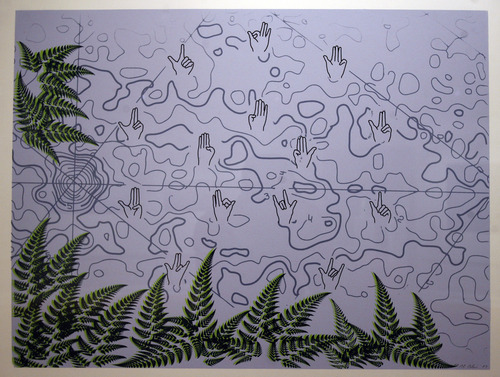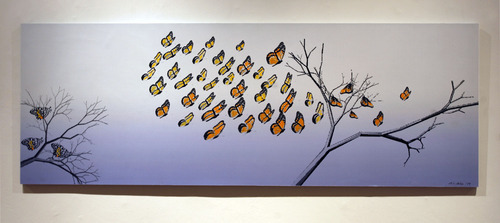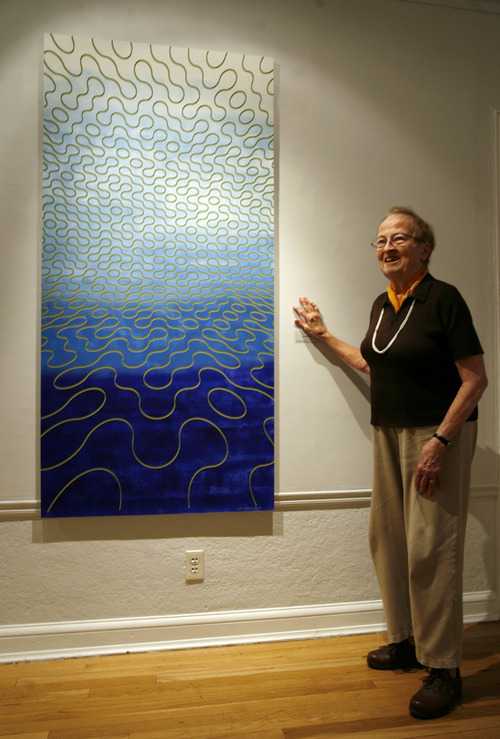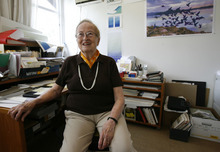This is an archived article that was published on sltrib.com in 2012, and information in the article may be outdated. It is provided only for personal research purposes and may not be reprinted.
At 86, Anna Campbell Bliss remains one of Utah's cutting-edge artists — passionately experimenting in color and spatial relationships, while probing the intersections of painting, math, language, dance and music.
Bliss overcame blindness caused by macular degeneration a few years ago and is still recovering from a bad fall that halted her work for two months. She joined the Modernist movement in the late 1940s and was a pioneer in exploring computer-generated art in the 1960s.
It speaks to Bliss' approach to life and art that the only complaint the artist voices in a recent interview concerns inelegant computer software. "I'm really disgusted at the moment," Bliss says. "I like to concentrate on my work and not the program. I like to speak directly to the computer — that's why I did a lot of programming [in C programming language]."
Bliss's work can be found at the University of Utah's Nursing Building and Cowles Mathematics Building, the State of Utah's Data Processing Center on Capitol Hill, St. Thomas More Church in Sandy, the Metropolitan Museum of Art in New York and many more. Now she's the subject of a documentary that will premiere Friday, March 9 at the Utah Museum of Contemporary Art.
Cid Collins Walker, a Washington, D.C., area-based filmmaker and Utah native, directed and produced "Arc of Light: A Portrait of Anna Campbell Bliss." Walker never forgot the impact Bliss had on her life in the 1970s when she lived in Salt Lake City. "I was deeply moved by Anna's work. I very much wanted to be her assistant," Walker says.
And Bliss, who didn't need a second assistant at the time, remembered Walker's creativity. "She was way ahead of other students and very interested in interpreting space," she says. Bliss recommended Walker for a fellowship at the Whitney Museum in New York.
Walker, who has been involved in art, dance and television production, says that when she decided to make a documentary, she asked herself: "What am I passionate about? I felt like Anna would be the perfect subject."
—
Exile to Utah • Bliss' artistic struggle will ring true for many artists living in Utah. She and her husband, Robert Bliss, had been deeply involved in Modernism in the late 1940s, studying with landmark figures such as designer and theorist Gyorgy Kepes and Bauhaus-influenced educator Josef Albers.
Anna Bliss had a degree in art history and mathematics from Wellesley College and went on to study architecture at Harvard, design with Kepes at the Massachusetts Institute of Technology, and engineering at New York University.
In the 1950s, the Blisses moved to Minneapolis, where they founded a joint architecture practice and immersed themselves in the art scene, including designing for the cutting-edge Walker Art Center.
Then Bob Bliss was offered a job in 1963 as chairman of the growing architecture department at the University of Utah. Anna was anything but excited to move to Salt Lake City/
"I'll admit I was in a very depressed mood when I got here," Bliss says. "I was very involved with the Walker and Minneapolis' art scene. I didn't find that degree of stimulation in the art world here."
Bliss was soon drawn to two areas of creative growth in Salt Lake City: dance and computer science. "I like the idea of movement," she says. "So many interesting ideas were being developed in computers. Many directions in the field were established at that time."
Then, in what Bob Bliss calls "a lifesaver" in the film, the couple bought an dilapidated mom-and-pop store on the west side of the city and renovated it into Anna's studio. She went on to establish the The Contemporary Arts Group in Salt Lake City. By the late 1980s, she had been commissioned to create public art in buildings at the Capitol and the University of Utah.
—
Computer nudes • Bliss' 8-by-25-foot 1996 work "Discoverers" at the Salt Lake International Airport, though successful, was a reminder of how conservative Utah could be.
"I included nudes in a minor way, just to establish a relationship between the ideas and people," she recalls. "Because of local attitudes, I couldn't have the nudes."
Her assistant suggested that she substitute computer-generated figures, which would speak to Utah's high-technology industries. Bliss remembers the incident with humor, especially the committee that regularly monitored the progress of her airport mural — she and her assistants called them the "Breast Patrol."
"You tune in [to local sensibilities]," Bliss says. "You don't necessary accept it, but you understand the limitations."
The visual-art scene and public support for it in Utah have "improved tremendously" since then, Bliss says, and many of the people on the Breast Patrol have become strong supporters of contemporary art.
"The climate has changed, but there were long periods of struggling for support," she says. But she acknowledges that the limited dollars available locally for visual arts is a challenge for institutions such as the Utah Museum of Contemporary Art and The Leonardo museum of art, science and technology.
Bliss fears that the lack of art education in Utah is the biggest challenge. "I wish the public schools were oriented more to art," she says. "Education needs to be reinforced in a visual way. I'm sorry that students don't have experiences with art earlier because they grow into legislators who don't have the slightest concept of what art is."
—
Arriving in Utah • Walker says her film emphasizes what Bliss accomplished — because she was culturally isolated from art world centers. Walker compares Bliss' experience to that of artist Georgia O'Keeffe, who relocated from New York to New Mexico.
"To bestow upon the world your gift as an artist, you really have to be isolated, whether in Utah or in a New York studio. It requires a very high degree of concentration," Walker says. "The more I lived with Anna as a subject, I saw that she is happy. She is sanguine. That's what Anna's message is to all of us, there is potential in everything we experience. It's about blazing a trail."
Unlike O'Keeffe, Bliss has yet to be widely recognized.
"If you are great, you are going to be great wherever you are," Walker says. "It doesn't matter when you arrive, just that you have arrived. It is Anna's turn for the world to see how brilliant she is."
gwarchol@sltrib.com; facebook.com/nowsaltlake —
Find your Bliss
"Arc of Light: A Portrait of Anna Campbell Bliss" will premiere in conjunction with the Utah Film Center. After the screening, Bliss will discuss her life as an artist.
Where • Utah Museum of Contemporary Art, 20 S. West Temple, Salt Lake City
When • Friday, March 9, 7 p.m.
Information • http://www.utahmoca.org, 801-328-4201 or http://www.arcoflight.org.











